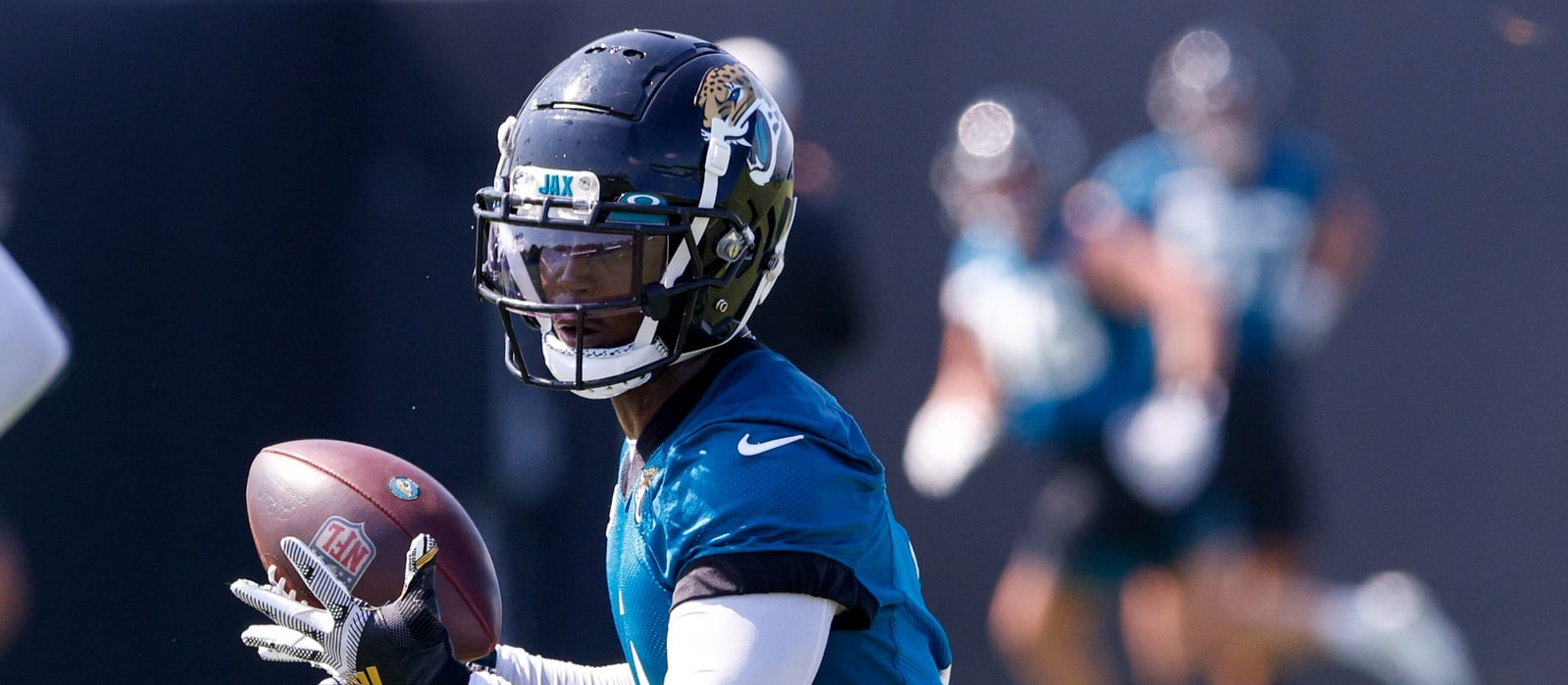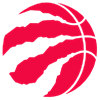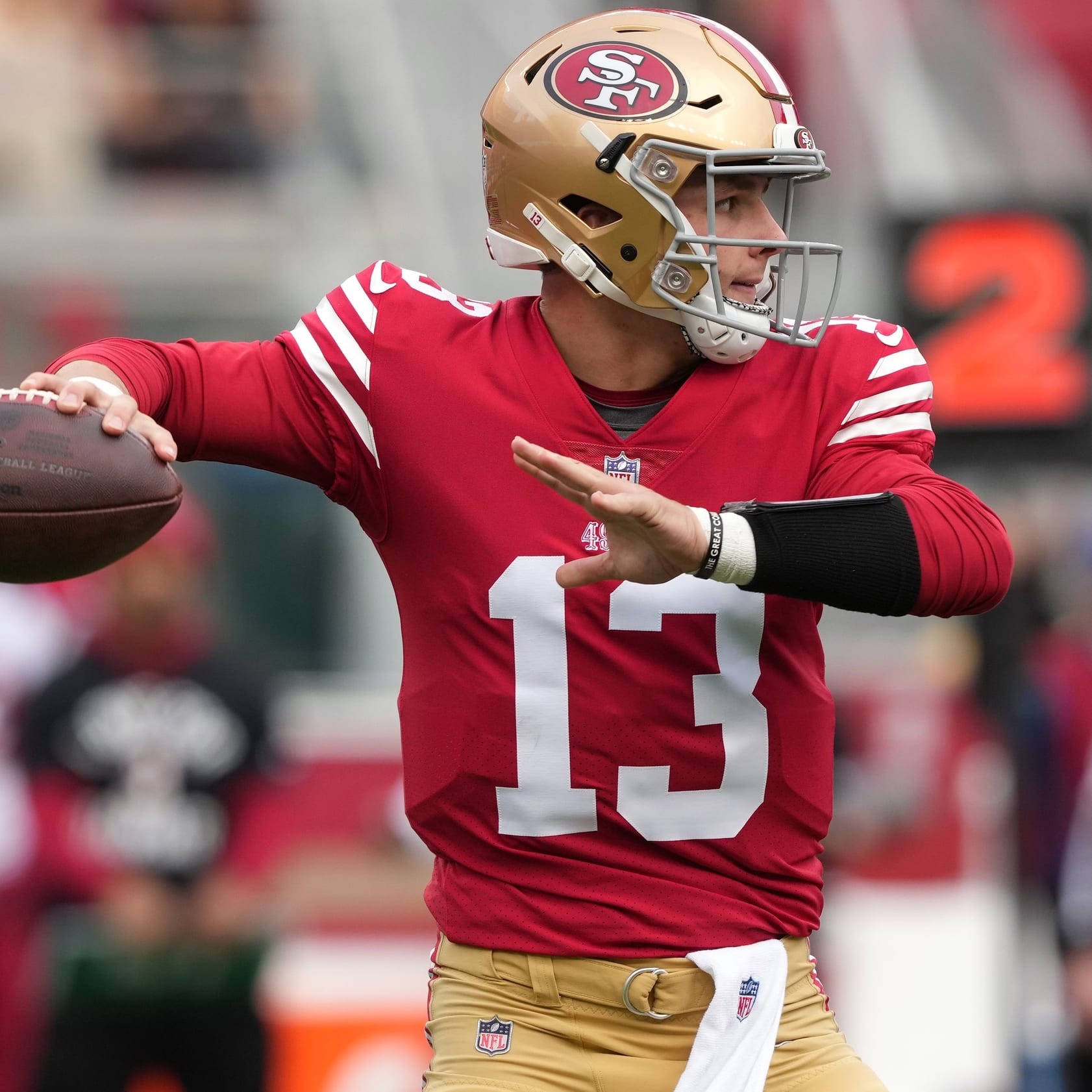It's crucial to build a fantasy roster's foundation by avoiding busts in the earliest rounds, and that's generally accomplished by targeting proven, dependable producers. After that, though, to pull away from the pack you must correctly identify speculative chances for profit — players who will outperform expectations. Predicting next year's high picks is easier said than done, of course, but breakouts usually happen for two reasons: 1) improved talent and/or 2) increased opportunities.
The first group tends to be young players, typically early draft picks. Michael Pittman's improved route running last year led to a 1,000-yard breakout.
The second group consists of players who either had increased playing time, increased touches or a change in team context. Cooper Kupp not only had more targets last year, but he finally had a quarterback who could throw downfield. The result was a massive breakout.
The ideal breakout would be a combination of these two categories, setting up the math for exponential production growth. Gabriel Davis could prove an example of this — he's expected to keep improving since he just turned 23, and he should get more playing time with Emmanuel Sanders no longer in Buffalo.
Justin Fields, QB, Bears
Summer ADP: No. 121, QB18
The poor guy doesn't have much help and his team likely won't be competitive, so Fields might have a difficult season in terms of real-life results. But even if the Bears lose a lot of games and even if Fields can't regularly lead them to
It's crucial to build a fantasy roster's foundation by avoiding busts in the earliest rounds, and that's generally accomplished by targeting proven, dependable producers. After that, though, to pull away from the pack you must correctly identify speculative chances for profit — players who will outperform expectations. Predicting next year's high picks is easier said than done, of course, but breakouts usually happen for two reasons: 1) improved talent and/or 2) increased opportunities.
The first group tends to be young players, typically early draft picks. Michael Pittman's improved route running last year led to a 1,000-yard breakout.
The second group consists of players who either had increased playing time, increased touches or a change in team context. Cooper Kupp not only had more targets last year, but he finally had a quarterback who could throw downfield. The result was a massive breakout.
The ideal breakout would be a combination of these two categories, setting up the math for exponential production growth. Gabriel Davis could prove an example of this — he's expected to keep improving since he just turned 23, and he should get more playing time with Emmanuel Sanders no longer in Buffalo.
Justin Fields, QB, Bears
Summer ADP: No. 121, QB18
The poor guy doesn't have much help and his team likely won't be competitive, so Fields might have a difficult season in terms of real-life results. But even if the Bears lose a lot of games and even if Fields can't regularly lead them to the end zone, his running ability could make him valuable in fantasy football. Fields possesses a rare combination of tools between his strong arm and sub-4.5 speed at 228 pounds, so he might be capable of some of the superhuman feats the Bears apparently expect of him with a lead wideout duo of Darnell Mooney and Byron Pringle. It might be a similar situation to Jalen Hurts in Philadelphia last year — a generally sluggish offense that puts pressure on its quarterback to bail out a weak passing game with a mix of scrambles and designed runs. Fields' rushing production could propel useful fantasy points.
Travis Etienne, RB, Jaguars
Summer ADP: No. 44, RB22
This requires a knock on wood as Etienne returns from the Lisfranc injury that ended his rookie season in training camp. It's a serious injury, and the bad-case scenario is still in play until he demonstrates full health. The good-case scenario must also be kept in mind, though, because Etienne was one of the most productive running backs in college football history at Clemson, where he ran for 4,952 yards and 70 touchdowns at a blistering 7.2 yards per carry. He also proved himself dangerous as a receiver, posting more than 1,000 receiving yards in his final 27 games. Etienne then paired that production with strong athletic metrics, including a 4.45 40 at 215 pounds, conclusively proving himself a blue-chip prospect. James Robinson (Achilles) is a good player in his own right, so playing time is an additional concern, but Jacksonville's enduring lack of receiver talent should help Etienne get involved as a pass catcher, creating room for both running backs to see double-digit touches most weeks.
Rashaad Penny, RB, Seahawks
Summer ADP: No. 94, RB33
Penny's breakout arguably already happened as he dominated the final six weeks of last season, rushing for a league-high 706 yards and six touchdowns on 102 carries (6.9 YPC). Skeptics dismiss the eruption as a fluke, and perhaps it will prove just that, but Penny's failures never had much to do with talent — rather, he was in a committee backfield and couldn't stay healthy. Incumbent starter Chris Carson's season-ending neck injury cleared up the playing time issue last year, and after some bumps early in the season, Penny's health finally cooperated for his late-season breakout. Even though it was the first time Penny produced in his four-year career, he still looked like the player who ran for 2,248 yards and 23 touchdowns (7.8 YPC) in his final 13 games at San Diego State. The selection of second-round pick Kenneth Walker crowds the backfield this season, but it also means the Seahawks likely will let Penny walk when his one-year deal expires. That could incentivize Seattle to feed Penny this year in hopes of keeping Walker fresh for his future as the lead back. What's more, Carson, whose status is uncertain as he's still recovering from the neck injury, is a major risk after missing more games (17) than he's played the last two seasons (16). Penny should be the first option in a run-heavy offense.
Elijah Moore, WR, Jets
Summer ADP: No. 71, WR32
Many assume 2022 first-round draft pick Garrett Wilson is the Jets' new WR1, but Moore will have something to say about that. It's easy to argue that Moore is as good a prospect as Wilson — Moore was exceptionally productive at Mississippi and torched his pro day with a 4.35 40 at 5-10, 178 — so he can mostly match Wilson's athleticism (4.37 40 at 183). With a one-year experience advantage over Wilson and having already produced at a standout level for a chunk of his rookie campaign, Moore should be considered the favorite to lead the Jets in targets this season. Although he's only four months older than Wilson, Moore already has 538 yards and five touchdowns to his credit, and he was quietly productive on a per-snap basis even in a doomed offense last year. He got open relentlessly, with 1.98 air yards per snap (95th percentile) and 1.78 yards per route run (79th percentile). Rather than Garrett Wilson, the concern with Moore would sooner be quarterback Zach Wilson, but Moore already showed the ability to produce despite poor QB play. If Zach improves, Moore really could go nuts.
Gabriel Davis, WR, Bills
Summer ADP: No. 63, WR28
There was plenty to like about Davis even before last year's playoffs. He was a legitimate alpha wide receiver at Central Florida with 391 yards as a true freshman and 815 as a 19-year-old sophomore, and through two NFL seasons he's caught 70 passes for 1,148 yards and 13 touchdowns on 125 targets over 1,368 snaps. That's good for about 797 yards and nine touchdowns per 950 snaps, at a catch rate of 56.0 percent and 9.2 yards per target. Those are already good numbers for a receiver, especially one in his age-21/22 seasons. As well as that all reflected on Davis, what he did in January was shocking, with his four TDs against the Chiefs setting an NFL playoff record while his 201 receiving yards were ninth most in playoff history. Davis accomplished that before his 23rd birthday and now heads into his third season with Emmanuel Sanders no longer in the way of a starting role. Davis' snap count and target volume should sharply increase this season, and he's probably not done developing, either. GM Brandon Beane is a huge fan, and Davis is about to show why.
Rashod Bateman, WR, Ravens
Summer ADP: No. 82, WR36
Bateman was one of the top receiver prospects of last year's draft, picked 27th overall, and the Minnesota product enjoyed a promising rookie season despite a sports hernia injury that delayed his arrival until Week 6. Even while playing five of his 12 games with backup quarterbacks, Bateman caught 46 passes for 515 yards and a touchdown on 68 targets and 575 snaps, in a season where he turned 22 at the end of November. His opportunities should skyrocket this year after Baltimore traded Marquise Brown to the Cardinals, setting the stage for Bateman to take over as the team's top receiver. The Ravens don't have much in the passing game besides Bateman and TE Mark Andrews, and even on a run-heavy team that should set up a second-year breakout. The Ravens are especially thin at WR with Brown gone, but Bateman's production at Minnesota implies he could just as easily claim a large target share on the basis of merit.
Christian Kirk, WR, Jaguars
Summer ADP: No. 103, WR42
Perhaps Kirk's much-criticized four-year, $72 million contract won't age well for the Jaguars, but that won't be a problem for Kirk's fantasy investors. If anything, the high pay dictates the Jaguars feed Kirk more targets than his former team did, which could set up a true breakout after the mini version last season. Kirk is at his best in the slot, where Larry Fitzgerald blocked him until 2021, at which point Kirk finally started to look more like the All-American he was at Texas A&M. After previously never exceeding 68 receptions or 709 yards in a season, Kirk had 77 catches for 982 yards and five touchdowns on 103 targets last year, good for an exceptionally efficient catch rate of 74.8 percent at 9.5 YPT. With Jacksonville, the efficiency will fall off a cliff, even if Trevor Lawrence makes major strides as a passer, but Kirk's target volume could explode as the best receiver in the Jaguars offense. Even if the offense is ugly again, Kirk could push for triple-digit receptions in Jacksonville. If Lawrence takes a step forward, there might even be some yardage and touchdowns to be had, too.
Rondale Moore, WR, Cardinals
Summer ADP: No. 122, WR50
Moore's rookie season was at once bizarre and mostly promising. The Cardinals insisted on using the former Purdue star and 49th overall pick in a unique role as a glorified screen-pass specialist, even though he's athletic enough (4.31 40, 42.5-inch vertical) to be dangerous downfield. The resulting numbers were strange. His 54 receptions went for just 435 yards and one touchdown, the product of an absurd 1.3-yard average target depth. The Cardinals gave Moore semi-regular targets, but only on screen passes. He averaged 8.1 yards after the catch, which is impressive given the predictable play calling and lack of route diversity. Now that Moore has a full year in the system, coach Kliff Kingsbury is all but compelled to expand his route tree and see what the second-round pick can offer, even with Marquise Brown in the fold. Moore's 5-7 frame means he won't win many jump balls, but he can still have an impact downfield given that he's one of the fastest players in the league. The six-game suspension for DeAndre Hopkins might give Kingsbury extra reason to come to this realization.
Allen Lazard, WR, Packers
Summer ADP: No. 123, WR51
The ceiling is limited with Lazard — no one should mistake him for a WR1, even if Green Bay cornered itself into placing him in that role this season – but he's probably the Packers' best overall receiver and is definitely the most versatile. Lazard has the build (6-5) and wingspan to log quality snaps outside, and his ability to box out defenders makes him useful from the slot or even TE-like alignments. Rookies Christian Watson (second round, North Dakota State) and Romeo Doubs (fourth round, Nevada) are faster than Lazard, but in the intermediate and underneath game, the veteran is Green Bay's best receiving option. That might make him the de facto WR1, over the likes of Watson, Doubs and Sammy Watkins, and if so, it sets up Lazard for a big season. His target competition is mostly coming from new faces who might not immediately sync with quarterback Aaron Rodgers, so Lazard's target share could be larger than his talent merits.
Irv Smith, TE, Vikings
Summer ADP: No. 135, TE14
Smith is entering his fourth year and has yet to hit 400 receiving yards in a season. A quick inspection, though, marks the 2019 second-round pick as a breakout candidate rather than a concern case. Smith entered the NFL young — he's still just 24 — and his 2021 season was wiped out by a meniscus injury. Fortunately, for those who could afford to wait, the payoff should finally arrive now that Smith is healthy and former teammate Tyler Conklin left for the Jets in free agency. The Vikings have no other serious competition for Smith, setting the stage for him to blast to a career high in playing time after a high of just 620 snaps in his rookie season. Smith should be one of the league's snap leaders at tight end, and in an offense with one of the league's most explosive collections of skill-position talent. With his playing time set to spike upward in a quality offense just as he approaches his own development peak, Smith is teed up for 2022.
Albert Okwuegbunam, TE, Broncos
Summer ADP: No. 142, TE17
Sometimes the obvious goes unnoticed, and in hindsight Okwuegbunam seems like one such case after he fell far into the fourth round of the 2020 Draft even though he produced at a standout level at Missouri and displayed freakish athleticism at the combine. Okwuegbunam is both one of the biggest (6-5, 258) and fastest (4.49 40) tight ends in the league, so it's not shocking the Broncos couldn't keep him off the field last year even as they committed to 2019 first-round pick Noah Fant as their starting tight end. Okwuegbunam likely is why Denver was willing to move Fant in the Russell Wilson trade this offseason, and now Okwuegbunam gets to start in a Wilson-led offense. He already made the most of his limited chances with Drew Lock and Teddy Bridgewater, ranking 90th percentile in yards per route last year, so now the stage is set for Okwuegbunam to really take off. Rookie third-round pick Greg Dulcich (6-4, 243, 4.70 40) is not likely a threat — Okwuegbunam is much bigger and much faster.
David Njoku, TE, Browns
Summer ADP: No. 157, TE19
Njoku has had a turbulent career, and broken the hearts of fantasy investors multiple times. It would be understandable to tune him out after those disappointments — it would also be a mistake. Njoku was an excellent prospect at Miami and showed elite athleticism at the combine with top-3 scores among tight ends in the vertical leap and broad jump and a 4.64 40. The 29th overall pick in 2017, Njoku was off to a promising start through his first two NFL seasons — including 639 yards and four touchdowns in his age-22 campaign — before a broken wrist and a feud with then-coach Freddie Kitchens plunged the tight end into obscurity for two years. Kitchens hasn't exactly been vindicated by history, so let's not hold Njoku's disappearance against him, especially now that the Browns are recommitting to him as their starting tight end and giving him the best QB he's ever had in Deshaun Watson. The Browns also gave him a four-year, $56.75 million extension in May with $28 million guaranteed. And he has less competition at the position this year with Austin Hooper now in Tennessee. The 6-4 Njoku has a huge catch radius and impressive leaping ability for a tight end, and now those loud tools should finally be unleashed.
MORE CANDIDATES
Tua Tagovailoa, QB, Dolphins - Perhaps Tagovailoa will never be truly good, but even a mediocre QB can provide stats with Tyreek Hill and Jaylen Waddle as his lead wideouts.
Trevor Lawrence, QB, Jaguars - The surrounding personnel in Jacksonville is still dubious, but going from perhaps the worst coach of all-time to the Super Bowl-winning Doug Pederson should be a helpful development for Lawrence.
Trey Lance, QB, 49ers - If Kyle Shanahan builds around Lance, the 2021 third overall pick could post huge fantasy numbers as a high-volume, highly explosive runner.
Clyde Edwards-Helaire, RB, Chiefs - Edwards-Helaire was the wrong pick for the Chiefs with Jonathan Taylor and others on the board, but he should emerge as the Chiefs' lead pass-catching RB in 2022.
Michael Gallup, WR, Cowboys - This is more of a "when, not if" kind of thing, because the only real question with Gallup is how quickly he can recover from his ACL tear and capitalize on the departure of Amari Cooper.
Parris Campbell, WR, Colts - Injuries wiped out a third year in a row for Campbell in 2021, but if he finally stays healthy he could rake as new QB Matt Ryan's primary slot receiver.
James Washington, WR, Cowboys - If Gallup's ACL recovery delays his 2022 arrival then Washington will have to pick up the slack – a task he's potentially up for despite brutal recent numbers with a declining Ben Roethlisberger.
Devin Duvernay, WR, Ravens - Offensive coordinator Greg Roman has yet to allow Duvernay to run downfield, but with Marquise Brown gone Duvernay is now the fastest Ravens receiver, even as one of their heaviest.
Bryan Edwards, WR, Falcons - Miscast as a downfield specialist in the Jon Gruden offense, watch Edwards break out as the Corey Davis to Drake London's A.J. Brown in Atlanta.
KJ Hamler, WR, Broncos - Patience is required since Hamler is still young (23) and returning from an ACL tear, but if he can force his way onto the field he would quickly turn into Russell Wilson's most dangerous downfield target.
Zay Jones, WR, Jaguars - Jones quietly played well for the Raiders down the stretch in 2021, and if Lawrence improves he could maintain that momentum for a full season.
Joshua Palmer, WR, Chargers - Palmer overtook Jalen Guyton as WR3 late last year with 18-185-3 in the final five weeks, setting himself up for bigger contributions this season.
Cole Kmet, TE, Bears - It's been a baptism by fire for Kmet his first two years, and he largely struggled under a demanding workload, but the Bears rushed his development for a reason: he's huge, athletic and has upside. That's still true.
Mo Alie-Cox, TE, Colts - MAC is one of the biggest, most athletic TEs and might be unleashed in a new look with Jack Doyle gone and Matt Ryan's killer middle-of-the-field accuracy contrasting with Carson Wentz's belligerent style.
This article appears in the 2022 RotoWire Fantasy Football magazine. Order the magazine now.
Take a look at our 2022 ppr fantasy football rankings.



































